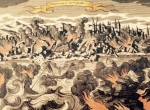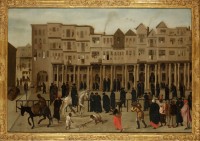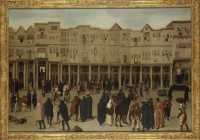 Most of Lisbon was at church when the earthquake hit. It was November 1st, 1755, All Saints’ Day, and the devout were at mass. The first shock struck at 9:40 AM with an estimated magnitude of 8.0 on the Richter scale. It lasted no more than six minutes, according to eye-witness accounts, but wreaked immense havoc in that time. Fissures as much as 15 feet long opened on the city streets. Almost all of the stone churches, particularly vulnerable as the tallest structures in the city, collapsed, killing the worshippers within. Aftershocks and 10:00 AM and noon compounded the destruction.
Most of Lisbon was at church when the earthquake hit. It was November 1st, 1755, All Saints’ Day, and the devout were at mass. The first shock struck at 9:40 AM with an estimated magnitude of 8.0 on the Richter scale. It lasted no more than six minutes, according to eye-witness accounts, but wreaked immense havoc in that time. Fissures as much as 15 feet long opened on the city streets. Almost all of the stone churches, particularly vulnerable as the tallest structures in the city, collapsed, killing the worshippers within. Aftershocks and 10:00 AM and noon compounded the destruction.
 Then came the fire. The candles in the churches and chapels are believed to have started dozens of small fires all over the city. The three massive tsunamis that struck the city in short succession after the quake only added to the devastation. They didn’t even have the decency to help put out the fires. Fed by the destruction of the quake and the impossibility of dousing the flames, the conflagration spread throughout Lisbon, burning for five days. By the time it was all over, 85% of Lisbon was in ruins, tens of thousands were dead and millions of pounds in trade goods were lost.
Then came the fire. The candles in the churches and chapels are believed to have started dozens of small fires all over the city. The three massive tsunamis that struck the city in short succession after the quake only added to the devastation. They didn’t even have the decency to help put out the fires. Fed by the destruction of the quake and the impossibility of dousing the flames, the conflagration spread throughout Lisbon, burning for five days. By the time it was all over, 85% of Lisbon was in ruins, tens of thousands were dead and millions of pounds in trade goods were lost.
 The city was rebuilt with notable efficiency, but its medieval downtown was irretrievably lost, including its main commercial thoroughfare, the Rua Nova dos Mercadores. There was little surviving evidence of what Lisbon had been. Paintings of the city were typically distant panoramic views, not the details of individual streets.
The city was rebuilt with notable efficiency, but its medieval downtown was irretrievably lost, including its main commercial thoroughfare, the Rua Nova dos Mercadores. There was little surviving evidence of what Lisbon had been. Paintings of the city were typically distant panoramic views, not the details of individual streets.
One very salient exception survived and was rediscovered in 2009 (pdf) by Annemarie Jordan Gschwend and Kate Lowe hanging on the walls of Kelmscott Manor in Oxfordshire. Kelmscott was briefly home to both William Morris, of Arts and Crafts Movement fame, and the pre-Raphaelite painter and collector Dante Gabriel Rossetti. Morris and Rossetti leased the country estate for a time, and the latter lived there for a few months in 1871 and then off and on for two years (1872-1874). He left abruptly after a falling out with Morris, leaving much of his treasured art collection behind in his haste.
 An avid collector of Old Masters when they could still be had for a song, Rossetti trawled the print shops, art and antiques shops of London for bargains. On April 3rd, 1866, he wrote to watercolorist George Price Boyce that he’d made an offer on a wonderful piece and hoped Boyce would stop by the shop to give it a look.
An avid collector of Old Masters when they could still be had for a song, Rossetti trawled the print shops, art and antiques shops of London for bargains. On April 3rd, 1866, he wrote to watercolorist George Price Boyce that he’d made an offer on a wonderful piece and hoped Boyce would stop by the shop to give it a look.
It is a large landscape with about 120 figures of the school of Velasquez — not by the great V. himself. I must needs feel pretty
sure, though it is so fine it almost might be but in abundance of interest as to subject & in grandeur of landscape, nothing could
well be more delightful.
His bid was accepted. In a letter to Edward Burne-Jones a couple of months later, Rossetti was considerably less circumspect about the authorship of his new treasure, calling it “the undoubted and stupendous Velasquez.” He was wrong both times. The painting was neither by Velasquez nor by his school. He did get the peninsula right, at least.
 Rossetti is known to have altered his Old Master paintings, overpainting them, “restoring” them, cropping them so they’d fit in his rooms which were crammed to the gills with paintings already. He took a drastic approach to the not-Velasquez. Some time between the purchase in 1866 and his departure from Kelmscott eight years later, Rossetti cut the wide panorama in two and framed them to hang as companion pieces. Yup, another one for the “because people are crazy” file. I mean, he’s so enthralled with the “120 figures” depicted in the piece but then he chops it in half? Nuts.
Rossetti is known to have altered his Old Master paintings, overpainting them, “restoring” them, cropping them so they’d fit in his rooms which were crammed to the gills with paintings already. He took a drastic approach to the not-Velasquez. Some time between the purchase in 1866 and his departure from Kelmscott eight years later, Rossetti cut the wide panorama in two and framed them to hang as companion pieces. Yup, another one for the “because people are crazy” file. I mean, he’s so enthralled with the “120 figures” depicted in the piece but then he chops it in half? Nuts.
 The view of Lisbon captured in the painting gives it international significance. The Rua Nova dos Mercadores was Lisbon’s largest road and the commercial center of the city. There are records of it going back to the 13th century. By the 16th century, Portugal was the capital of a global empire and the Rua Nova dos Mercadores offered every kind of luxury import — cotton textiles from India, silks from the Far East, Ming porcelain, exotic medicines (rhino horn, bezoar stones) — in a dozens of shops. Records from 1552 count 20 textile shops, 11 bookstores, six porcelain shops and nine drug stores occupying the ground floors of the 90 or so buildings lining the street.
The view of Lisbon captured in the painting gives it international significance. The Rua Nova dos Mercadores was Lisbon’s largest road and the commercial center of the city. There are records of it going back to the 13th century. By the 16th century, Portugal was the capital of a global empire and the Rua Nova dos Mercadores offered every kind of luxury import — cotton textiles from India, silks from the Far East, Ming porcelain, exotic medicines (rhino horn, bezoar stones) — in a dozens of shops. Records from 1552 count 20 textile shops, 11 bookstores, six porcelain shops and nine drug stores occupying the ground floors of the 90 or so buildings lining the street.
The architecture of the street — the iron railing, the portico with 149 columns, the tall narrow houses with flat roofs at each end and peaked roofs in the middle — was one of the key pieces of information that allowed Gschwend and Lowe to identify it as Lisbon’s Rua Nova dos Mercadores.
Here’s a virtual recreation of the street as it was before the earthquake.
There was a lot more business going on that just road traffic retail. The iron fence in the midground of the painting was a sort of velvet rope. Within its protective confines, merchants, bankers and assorted salesmen made deals and talked shop without having to rub shoulders with the hoi polloi. The painting depicts these wealthy traders and money men dressed in black cloaks and hats, a look known as the Spanish style, mingling behind the iron fence, while in front and to the side street vendors, children, farmers, labourers, performers, assorted foreign types and slaves hustle and bustle.
The high proportion of Africans in the picture was another of the key features that identified it as a depiction of pre-earthquake Lisbon. Lisbon was unique for a European city of its time for its large number of black people, mostly slaves, imported from Portuguese bases in western Africa. For more than a hundred years, Portugal dominated the slave trade and transported thousands of them to Lisbon itself. By 1551, an estimated 10% of the population of 100,000 was black. In 1578, about 20% of the 250,000 Lisbonites were black.
It’s not just the multicultural population in the picture that underscores Portugal’s imperial reach. Even the animals attest to it. In the second half of the painting, you can see a dog mauling a bird in the bottom left corner. Look closely at that bird. It’s a turkey, a New World bird that Portugal introduced not just to its capital, but to India, Africa and the Far East as well.
 The global empire captured in the details of Rua Nova dos Mercadores will be the focus of a new exhibition at Lisbon’s Museu Nacional de Arte Antiga. The Global City: Lisbon in the Renaissance aims to recreate some of the Lisbon obliterated in the earthquake. The Rua Nova paintings will be displayed in Lisbon for the first time (that we know of), and will be accompanied by precious objects and artworks from all over the empire, like an intricately carved snake-themed ivory salt cellar base from Sierra Leone and a Processional Cross once owned by Catherine of Braganca made out of a narwhal tusk and containing the relics of Saint Thomas Becket. All told, the museum has assembled an unprecedented group of 249 pieces from 77 lenders from private collectors to public institutions.
The global empire captured in the details of Rua Nova dos Mercadores will be the focus of a new exhibition at Lisbon’s Museu Nacional de Arte Antiga. The Global City: Lisbon in the Renaissance aims to recreate some of the Lisbon obliterated in the earthquake. The Rua Nova paintings will be displayed in Lisbon for the first time (that we know of), and will be accompanied by precious objects and artworks from all over the empire, like an intricately carved snake-themed ivory salt cellar base from Sierra Leone and a Processional Cross once owned by Catherine of Braganca made out of a narwhal tusk and containing the relics of Saint Thomas Becket. All told, the museum has assembled an unprecedented group of 249 pieces from 77 lenders from private collectors to public institutions.